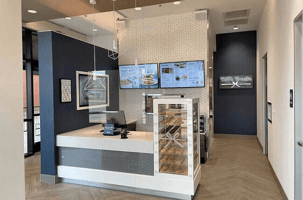The use of technology in educational spaces has become essential and advantageous as the digital era advances. This shift is transforming the traditional classroom into a dynamic environment that fosters learning through play and digital platforms. Modern classrooms' millwork is crucial in ensuring that educational spaces are not only functional but also conducive to learning. Today we’ll go over different types of technology that make this possible.
Custom Millwork: The Backbone of Tech-Integrated Classrooms
The integration of technology into classrooms is facilitated by custom millwork in educational spaces. These are examples of how tailored solutions are enhancing the functionality of tech-equipped learning environments:
Encasing Technology in Functionality
A significant challenge in incorporating technology into classrooms is managing the equipment without negatively impacting space or design aesthetics. Custom millwork offers elegant solutions by housing technology within beautifully designed furniture. Incorporating millwork technology into the classroom can be exemplified by podiums equipped with built-in screens, desks that feature discreet spaces for tablets and laptop computers or wall-mounted charging stations in bookcases.
Adapting to Changing Technological Needs
Technology evolves at a rapid pace, and educational spaces must be designed to adapt to these changes. Modular millwork solutions allow for technological enhancements without requiring extensive space redesign. This flexibility allows classrooms to keep pace with technology so that learning becomes more effective and engaging for students.
Promoting Interactive Learning Environments
Technology enhances education by promoting collaboration and interaction among students, rather than just individual learning. Millwork is essential in creating environments that encourage this collaborative learning. The use of custom-made workstations can promote collaboration among students and facilitate discussion.
Integrating Technology with Design Aesthetics
While functional aesthetics are important, the use of technology in educational spaces is equally important for its impact. Optimal design of millwork not only facilitates the logistical aspects of technology integration but also creates an enjoyable and stimulating learning atmosphere.
Harmonizing Technology with Decor
By utilizing design and craftsmanship, it is possible to incorporate technology without making it an intrusive element. Integrated millwork can enhance the aesthetic appeal of a classroom by incorporating technological elements into the decor through its materials, colors, and finishes.
Enhancing the Learning Atmosphere
Student engagement and learning outcomes are influenced by the physical environment. Custom millwork and thoughtfully considered technology can enhance the aesthetics and functionality of educational spaces. The integration of technology and design contributes to the achievement of educational goals and fosters a more engaging and stimulating learning experience for students.
Conclusion
The incorporation of technology into contemporary classroom design marks a turning point in the way educational settings are imagined and constructed.st. Custom millwork is spearheading this transformation, providing the infrastructure needed to integrate technology into educational spaces. Designed to meet the needs of today’s digital learners, millwork solutions are creating dynamic, interactive and flexible learning environments by emphasizing both functionality and aesthetics.






.png?width=203&height=142&name=IFA%20Member%20Logo%20EPS%20(1).png)
.png%20for%20web.png?width=203&height=94&name=2022_VetFran_Logo%20(002).png%20for%20web.png)
.png?width=203&height=150&name=ICSC-logo-tag-full-color%20(1).png)